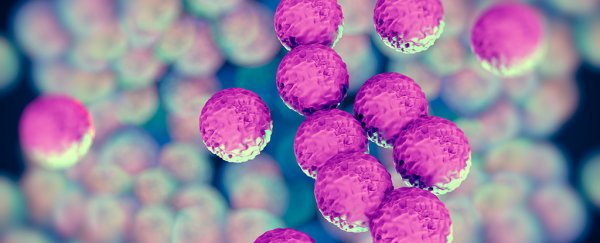A bacterium called Staphylococcus epidermidis is right now making itself at home on your skin. Don't panic – it's on all of us – and usually isn't a call for alarm.
But because it's so common, it means medical clinicians overlook its dark side – one that could become deadly should it learn to evade most antibiotics, and new research suggests we seriously ought to be paying it a lot more attention.
Researchers from the Milner Centre for Evolution at the University of Bath have discovered more than 60 genes that can turn this rather innocuous microbial citizen into a tenant from hell.
"Staphylococcus epidermidis is a deadly pathogen in plain sight," says the study's lead researcher, Sam Sheppard.
Most people are fairly familiar with this bacterium's cousin, Staphylococcus aureus, commonly referred to as golden staph.
Golden staph also lives on our body without making much of a fuss. But if it does happen to cause an infection, it can become deadly for up to a third of patients within a year.
Antibiotics are the go-to weapon of choice in these circumstances, but some strains of golden staph have developed ways to resist a variety of treatments, becoming notorious pathogens (aka superbugs).
But Methicillin-resistant Staphylococcus aureus – or MRSA – is just one superbug that gets a lot of press these days.
Other emerging strains, such as some types of Klebsiella pneumoniae, are less common, but grab headlines as they turn ordinary infections into life-threatening conditions.
S. epidermidis isn't categorised like these other pathogens. It's literally unavoidable, so it slips under the radar.
"It's always been ignored clinically because it's frequently been assumed that it was a contaminant in lab samples or it was simply accepted as a known risk of surgery," says Sheppard.
Infections might be par-for-the-course after an operation, but noting which common microbes have the potential to escalate health problems could make all the difference for some.
"If we can identify who is most at risk of infection, we can target those patients with extra hygiene precautions before they undergo surgery," says Sheppard.
The risk isn't just related to complacency on the issue. Because S. epidermidis is so common, having huge numbers of the bacterium in any one location makes it easy for genes to jump between individuals like phone numbers at a nightclub.
If those genes happen to carry the formula for some kind of antibiotic resistance, it won't take long for this garden variety infection to become a problem for an entire hospital.
"If we do nothing to control this, there's a risk that these disease-causing genes could spread more widely, meaning post-operative infections that are resistant to antibiotics could become even more common," says Sheppard.
In the study, the researchers analysed more than 400 isolates made up of samples of S. epidermidis, including a number taken from healthy volunteers and surgical patients. These specimens had their genomes read and various infectious functions measured.
The end result was an evaluation of their overall pathogenicity according to genetic elements called k-mers, which could assist infection.
All up, there were 61 genes containing k-mers that could help give any single infection enough of an edge to cause big problems.
These ranged from simply having a knack for making better 'microbial glue' for hard-to-budge biofilms, to boosting toxic compounds, or making the bugs resistant to the Staph-murdering antibiotic, methicillin.
Knowing more about these kinds of genetic characteristics could help pathologists better identify problematic infections, and help physicians devise a better course of action if people become infected.
Right now, more work needs to be done simply to identify what would be the dangerous strains from an inevitable laboratory contamination.
Researcher Dietrich Mack from the Bioscientia Institute for Medical Diagnostics GmbH, Germany, knows the problems that can arise if a potential infection is overlooked as something more innocent.
"These infections are difficult to diagnose and there is hope that disease-associated genes may help to separate harmless skin isolates from disease-causing S. epidermidis strains in the clinical laboratory," says Mack.
"This needs to be addressed in future studies."
This research was published in Nature Communications.
